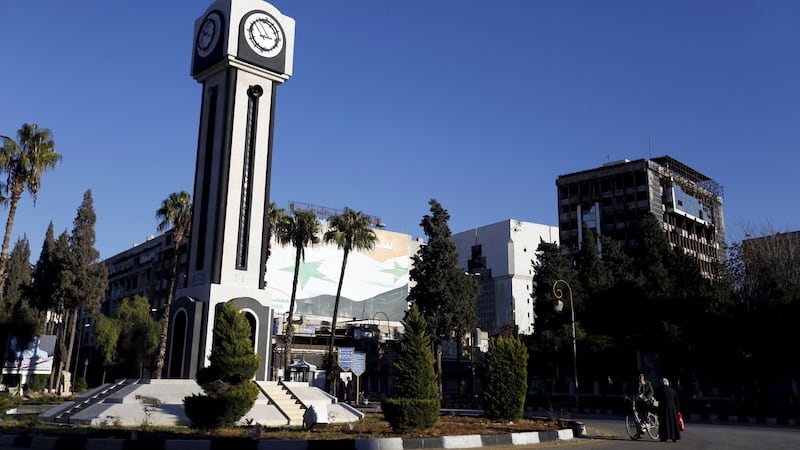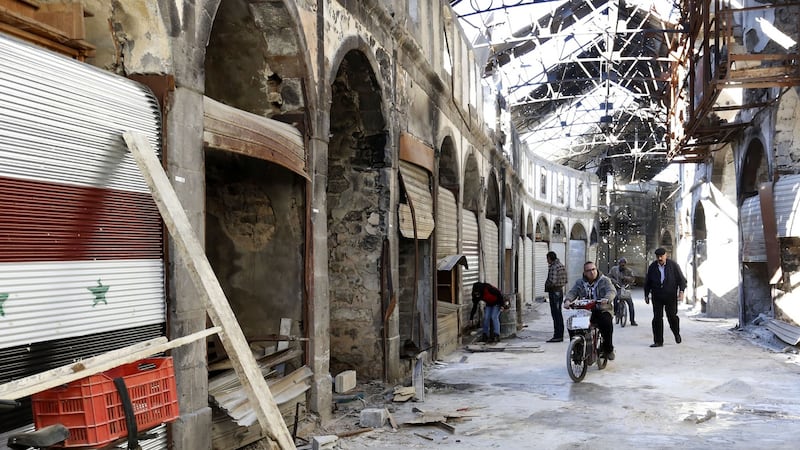A red, white and black Syrian flag flys over an abandoned firing position consisting of rusty barrels wedged between two ancient columns at Palmyra Square at the entrance to Homs. It sums up the current situation in Syria’s war-torn third largest city: Damascus now reigns over the city dubbed the “hub of the revolution”.
The green, white and black flag of the rebellion has been struck and the guns have fallen silent in al-Waer district, the last to remain under insurgent control, following a UN-brokered truce and the December 9th evacuation of 719 of 2,700 fighters and civilians.
Northwest province


The rest of the fighters and their families are due to relocate to the northwest insurgent-held province of Idlib by early February. Before the crisis al-Waer was home to 300,000. Now there are about 75,000 and many of them are people who have been displaced from other areas.
The sole entrance to al-Waer is a passage at the edge of a Syrian army camp on the western outskirts of the city. Civilians come and go, carrying bags of supplies that are checked by soldiers sitting at a table under a simple shelter.
A pick-up piled high with crates of eggs and two small lorries carrying defrosting frozen meat wait for approval.
Dr Zacharia al-Shaar is supervising the loading of his van with boxes of medical supplies, such as those for dialysis, for al-Birr hospital, which is run by a charitable organisation. The hospital offers free treatment to all, including fighters, he says.
“The situation is better now but foreign fighters remain. They don’t want reconciliation; they take orders from outside.”
Among them are Chechens, Saudis, Afghans, Tunisians and Libyans who entered al-Waer through tunnels that have been destroyed by the army.
“Water is okay. We have nine to 10 hours of power,” he says, eliciting a quip from my Damascene driver, Joseph, “I think I’ll come live here.”
Fresh bread
At the checkpoint, which is delineated by a few strands of wire and rubbish, boys of nine and 10 await parcels of freshly-baked bread to take home to their families. The vast mechanised government-run bakery in a nearby warehouse supplies each household with eight loaves a day at about $0.16 (€0.14) a parcel. Fresh food brought in by merchants is expensive. Basic supplies – such as rice, oil, sugar and lentils – are provided by humanitarian agencies granted intermittent access.
Opponents of the truce in al-Waer responded with a December 13th triple bombing that killed 22 and wounded 104 in the eastern pro-government neighbourhood of Zahra, formerly inhabited by Alawites, the community of president Bashar al-Assad, but now a mixed area due to the influx of displaced families.
Homes on both sides of the targeted street were devastated by the explosions. External walls evaporated or collapsed.
One man scrapes away at the rubble on the floor of an office for driving licences in a building where four members of the Hamdan family died and six were wounded.
His arm bandaged, bones pinned with metal spikes, Imad al-Hamwey says, “A man came at 11 o’clock and asked us to move a lorry bringing bottles of cooking gas so he could park an ambulance for a few minutes as he had to go to the [nearby] hospital. He blew up the ambulance causing the gas to explode then waited until the army and rescue squads came before returning and exploding his suicide vest.
“How can anyone do this? What kind of mentality do they have? They are totally brainwashed. This man spoke to us before exploding his bombs.” Following the bombings, the loyalist quarter protested against the government’s failure to provide protection.
Meanwhile, the Old City, evacuated by fighters in May 2014, basks in the afternoon sun. Rubble has been cleared from the streets and electricity restored although rationed.
Damaged homes have been repaired and families are returning. Reopened schools are drawing them back, prompting shops and restaurants to revive. A decorated Christmas tree gleams in the window of Al-Bustan, a popular restaurant advertising seasonal feasts.
At the Orthodox School for Girls, founded in 1894, a torrent of laughing girls and boys pour through the gate and into the street at the end of classes. Headmistress Shadia Khoury says the school – nursery through baccalaureate – has 216 pupils.
Restored buildings
It opened in October after its elegant freshly painted buildings were restored. The city’s emblematic New Clock Tower, which was refurbished, cleaned and the mechanism restarted after the May 2014 evacuation of the Old City, presides over reconstruction while the Old Clock Tower, a clock face mounted on a lamp post, stands in a vast square surrounded by devastation.
Meanwhile in the “new” city, the “Grafton Street” of central Homs remains largely unscathed although car and suicide bombers are always a risk. A large shop displays elegant bridal dresses, another shows expensive perfumes from distant Paris. Traffic ebbs and flows. Schoolgirls in white headscarves giggle as I take their photos while cheeky preteen boys try to butt in.
Contrary to reports, Homs is not “destroyed”. Homs is alive and trying to recover from the first 21st century conflict to afflict an ancient land long subjected to warfare.

















